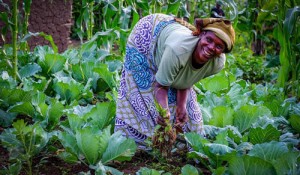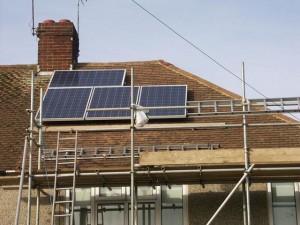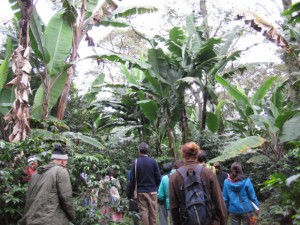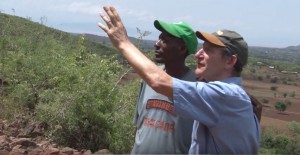 According to the International Panel on Climate Change (IPCC), food insecurity is expected to rise between 15-40 percent by the year 2050. Furthermore, a policy brief by the World Agroforestry Centre highlights that smallholder farmers find it hard to innovate and invest in better management systems especially when they are preoccupied with finding other means of survival that are less costly and will take shorter time to achieve the desired benefits. It is therefore imperative that our agriculture and the food system is reformed to increase resilience to the impacts of climate change and other shocks that arise including: escalating food prices, deforestation and depletion of natural resources. Here are some suggestions on how to counter the issue
According to the International Panel on Climate Change (IPCC), food insecurity is expected to rise between 15-40 percent by the year 2050. Furthermore, a policy brief by the World Agroforestry Centre highlights that smallholder farmers find it hard to innovate and invest in better management systems especially when they are preoccupied with finding other means of survival that are less costly and will take shorter time to achieve the desired benefits. It is therefore imperative that our agriculture and the food system is reformed to increase resilience to the impacts of climate change and other shocks that arise including: escalating food prices, deforestation and depletion of natural resources. Here are some suggestions on how to counter the issue
Monthly Archives: February 2016
Reform agriculture and food systems against the impacts of climate change in South Sudan
Bringing better biodigesters and clean energy to Africa
 Sub-Saharan Africa continues to suffer from a major energy deficit, with hundreds of millions of people lacking access to electricity and clean cooking fuels. There is a great need for innovative mechanisms that can help families access clean and affordable energy. The Carbon Initiative for Development (Ci-Dev) is one such mechanism. A $125 million fund with a pipeline of 14 pilot projects in Africa, Ci-Dev will help improve living standards and sustainable energy through results-based finance. Along the way, it will generate valuable lessons in how reducing greenhouse gas emissions can generate tangible development benefits for local communities, like cleaner air, improved safety, and financial and time savings. These lessons can help in the delivery and scale up of innovative climate finance business models.
Sub-Saharan Africa continues to suffer from a major energy deficit, with hundreds of millions of people lacking access to electricity and clean cooking fuels. There is a great need for innovative mechanisms that can help families access clean and affordable energy. The Carbon Initiative for Development (Ci-Dev) is one such mechanism. A $125 million fund with a pipeline of 14 pilot projects in Africa, Ci-Dev will help improve living standards and sustainable energy through results-based finance. Along the way, it will generate valuable lessons in how reducing greenhouse gas emissions can generate tangible development benefits for local communities, like cleaner air, improved safety, and financial and time savings. These lessons can help in the delivery and scale up of innovative climate finance business models.
What next after COP 21?
 Late last year the world reached a landmark agreement on climate change in Paris, a fundamental pivot toward a zero-carbon and climate-resilient world. However, key steps lie ahead to bring the agreement to fruition:
Late last year the world reached a landmark agreement on climate change in Paris, a fundamental pivot toward a zero-carbon and climate-resilient world. However, key steps lie ahead to bring the agreement to fruition:
- Countries are expected to finalize their current national climate plans and shift them from being Intended Nationally Determined Contributions (INDCs) into Nationally Determined Contributions (NDCs) for the Agreement to take effect
- Each country must sign and indicate their consent to be bound by the Agreement and will only take effect once 55 parties to the UNFCCC representing atleast 55% of total global greenhouse gases sign for it to be legally binding
- On April 22, 2016, All Heads of State will sign the Agreement at a high-level signing ceremony at the United Nations in New York on 26th April 2016. The Agreement will then be open for signature for one year, until April 21, 2017
- Each country will be required to fulfill its necessary domestic processes and deposit an “instrument of ratification, acceptance or approval” which will indicate that the country has completed all necessary processes and can now join the Agreement
- After the one-year signing period, the Agreement will be open for accession, which is a term used when a country becomes a Party to an international agreement that other countries have already signed
- The Agreement will be in full legal force and effect when at least 55 Parties to the UNFCCC that account for at least 55 percent of the total global greenhouse gas emissions have deposited their instruments of ratification, acceptance, approval or accession. This will depends on how quickly individual countries will be able to complete their domestic approval processes. Once the Agreement enters into force, the first meeting of the Parties to the Agreement will occur in conjunction with the next COP
The smart money is going green
 The world economy is moving in a low-carbon direction, drawing investors to carbon-intensive sectors. This is attributed to innovations that lower the price of renewable energy much faster than anticipated. The cost of solar panels for example has had an 80% decrease since 2008, and solar and wind energy can now compete on cost with fossil fuels in many regions worldwide. This has translated to a drastic market shift with new clean power capacity exceeding that of new fossil fuel capacity, and this is expected to continue in coming years. According to research from Corporate Knights, 14 funds holding more than $1 trillion in assets could have saved $22 billion had they shifted investments from the highest carbon companies to those that receive at least 20 percent of revenues from environmental markets or clean energy.
The world economy is moving in a low-carbon direction, drawing investors to carbon-intensive sectors. This is attributed to innovations that lower the price of renewable energy much faster than anticipated. The cost of solar panels for example has had an 80% decrease since 2008, and solar and wind energy can now compete on cost with fossil fuels in many regions worldwide. This has translated to a drastic market shift with new clean power capacity exceeding that of new fossil fuel capacity, and this is expected to continue in coming years. According to research from Corporate Knights, 14 funds holding more than $1 trillion in assets could have saved $22 billion had they shifted investments from the highest carbon companies to those that receive at least 20 percent of revenues from environmental markets or clean energy.
Its therefore time for companies and investors to make 2016 a ‘year of green finance’ by putting efforts to reduce emissions on their priority list for investment and risk management. Green banks are already successfully leveraging private capital in a number of countries and proving that such investments can be profitable. For instance, the UK Green Investment Bank expected to earn taxpayers a return of 10 percent in 2015, while China and Brazil provided low cost and long-term debt for renewable energy. However, much work still lies ahead and public capital must play a key role. without financing, the upfront costs of clean energy can deter investors and obscure the future cost advantages from lower fuel and operating costs.
Click here for the full article
Ethiopia and Malawi success stories on FMNR practices
“FMNR is really important for climate change. Already, without any dollar, lots of poor farmers, just with a machette, have re-greened their country and provided good food for their children,” notes Tim Costello, Chief Executive Officer at World Vision Australia.
A Global Wiki of Perennial Crops, Polycultures, and Food Forest Sites
 Designing perennial polycultures (guilds) can be a big challenge. Furthermore, resources and information to help design perennial polycultures are few and far between. In order to address this research gap, The Apios Institute, an organization aiming at sharing experiences and information on perennial crop polyculture systems, was formed. The organization through a collaborative network of farmers, gardeners, and researchers, shares inspiration and fills critical knowledge gaps regarding the design and management of these systems. Additionally, it is a place for growers and enthusiasts to share personal experiences, observations, and research.
Designing perennial polycultures (guilds) can be a big challenge. Furthermore, resources and information to help design perennial polycultures are few and far between. In order to address this research gap, The Apios Institute, an organization aiming at sharing experiences and information on perennial crop polyculture systems, was formed. The organization through a collaborative network of farmers, gardeners, and researchers, shares inspiration and fills critical knowledge gaps regarding the design and management of these systems. Additionally, it is a place for growers and enthusiasts to share personal experiences, observations, and research.
Click here to learn more about the initiative


